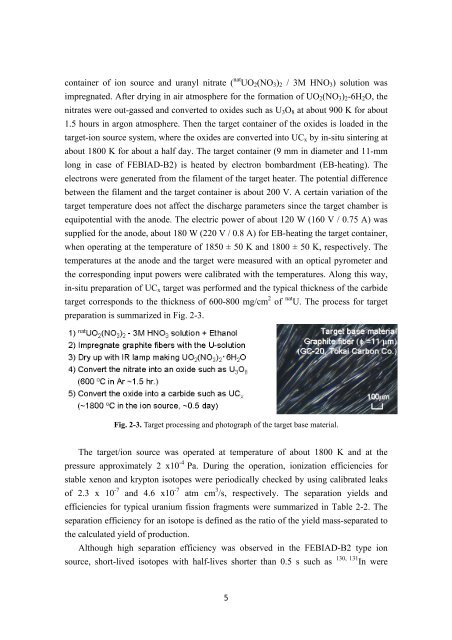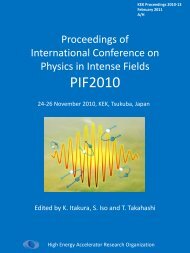TRIAC Progress Report - KEK
TRIAC Progress Report - KEK
TRIAC Progress Report - KEK
You also want an ePaper? Increase the reach of your titles
YUMPU automatically turns print PDFs into web optimized ePapers that Google loves.
container of ion source and uranyl nitrate ( nat UO2(NO3)2 / 3M HNO3) solution was<br />
impregnated. After drying in air atmosphere for the formation of UO2(NO3)2-6H2O, the<br />
nitrates were out-gassed and converted to oxides such as U3O8 at about 900 K for about<br />
1.5 hours in argon atmosphere. Then the target container of the oxides is loaded in the<br />
target-ion source system, where the oxides are converted into UCx by in-situ sintering at<br />
about 1800 K for about a half day. The target container (9 mm in diameter and 11-mm<br />
long in case of FEBIAD-B2) is heated by electron bombardment (EB-heating). The<br />
electrons were generated from the filament of the target heater. The potential difference<br />
between the filament and the target container is about 200 V. A certain variation of the<br />
target temperature does not affect the discharge parameters since the target chamber is<br />
equipotential with the anode. The electric power of about 120 W (160 V / 0.75 A) was<br />
supplied for the anode, about 180 W (220 V / 0.8 A) for EB-heating the target container,<br />
when operating at the temperature of 1850 ± 50 K and 1800 ± 50 K, respectively. The<br />
temperatures at the anode and the target were measured with an optical pyrometer and<br />
the corresponding input powers were calibrated with the temperatures. Along this way,<br />
in-situ preparation of UCx target was performed and the typical thickness of the carbide<br />
target corresponds to the thickness of 600-800 mg/cm 2 of nat U. The process for target<br />
preparation is summarized in Fig. 2-3.<br />
Fig. 2-3. Target processing and photograph of the target base material.<br />
The target/ion source was operated at temperature of about 1800 K and at the<br />
pressure approximately 2 x10 -4 Pa. During the operation, ionization efficiencies for<br />
stable xenon and krypton isotopes were periodically checked by using calibrated leaks<br />
of 2.3 x 10 -7 and 4.6 x10 -7 atm cm 3 /s, respectively. The separation yields and<br />
efficiencies for typical uranium fission fragments were summarized in Table 2-2. The<br />
separation efficiency for an isotope is defined as the ratio of the yield mass-separated to<br />
the calculated yield of production.<br />
Although high separation efficiency was observed in the FEBIAD-B2 type ion<br />
source, short-lived isotopes with half-lives shorter than 0.5 s such as 130, 131 In were<br />
5













